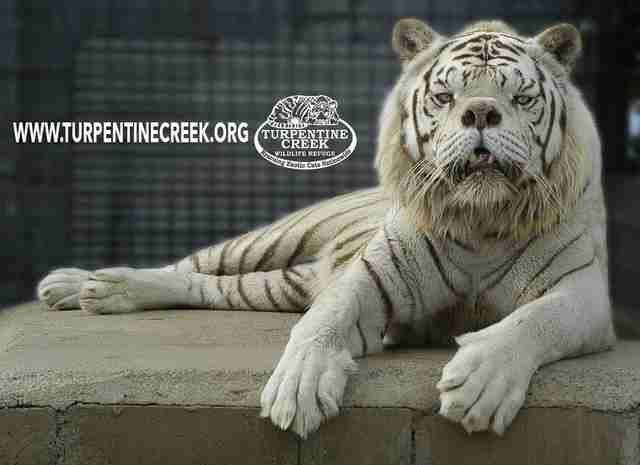What are hybrid cats?
Hybrid cats are the result of crossbreeding two different species of cats. The most common example of big cat hybrid is the “liger”, which is a cross between a female tiger and a male lion. However, there have been many other hybrids that have resulted from captive breeding, such as tigons (male tiger/female lion), leopons (lion/leopard), and jaglions (jaguar/lion). Smaller crossbreeds include the savannah cat (serval/domestic cat) which are a popular “designer” exotic pet.
Contrary to what many zoos and exotic wildlife owners will argue, hybrid cats do not frequently occur in the wild. Theoretically there is the potential that ligers, for instance, may have existed at some point in the wild when there was greater territorial overlap. However, the current geographical differences between tigers and lions makes it unlikely to occur. Additionally, although they share a common ancestor, both species are separated by about 4.5 million years of evolution, with tigers evolving specialized behaviour that lions lack (Figuerio et al., 2017).
So why do so many exist in captivity? “Hybridization” of big cats has been criticized over the years as being unethical because there is no point to their creation. They do not need conservation since they don’t exist in the wild, and often these hybrids end up with genetic issues that are not present in their parent species. The only reason they continue to be bred in captivity is because of their popularity, which in turn generates revenue.
Is it inhumane to breed ligers?
Brought into the limelight by the movie Napoleon Dynamite, ligers have become fairly famous and this fame has led to zoos increasingly breeding them. It is clear that profit is the only reason they exist in such large numbers, and as mentioned, they don’t exist in the wild. It can be argued that since it is unnecessary to breed them, it is also inhumane. There have been other arguments made as well about their size contributing to health problems, which will be discussed.
Ligers can grow to enormous sizes (far larger than their parent species), with the largest on record weighing over 900 lbs. While researchers originally believed that this excessive growth was caused by gigantism (which occurs when there is an excess of uninhibited growth hormone), it is now thought to be caused by imprinting genes.
Imprinted genes exist in the DNA of the lion and tigers’ reproductive material before breeding even occurs. These genes are either switched ‘on’ or ‘off’ depending on the genetic priorities of that species, which is affected by things such as their lifestyle or habits. For instance, lions live in prides and tigers are solitary. A lionness will typically mate with all of the pride’s lions. The lion will want to ensure his cubs are the most successful, so there is genetic incentive to have the “biggest” cubs in such a competitive environment. By contrast, the lioness will want to ensure all her cubs survive and be the same size. This means there is a counterbalance. Tigresses, however, will only mate with one male tiger given their solitary nature. Since the male tiger is not competing with other males, there is no need to have the “growth” incentive, which means the tigress has no anti-growth inhibitor gene. When a male lion and a tigress are bred, the tigress has no way of inhibiting the lion’s growth gene, which results in excessively large liger offspring (Discover Magazine, Stanford at the Tech).
While Ligers are not always sterile and some have been able to produce offspring.
What are colour mutations?
Colour mutations can occur in big cats when the recessive genes for these colours are expressed; this means that both parents must carry the recessive gene in order for the colour to appear. While there are a number of recessive mutations that can occur, there are four that are most commonly discussed in the context of big cats:
Leucism: Leucism is a mutation that causes a partial loss of pigment/melanin. This results in a white colouration in animals, with lighter colored (typically blue) eyes and skin. It is a different mutation from “albinism”. It has been speculated by researchers that this is the mutation which causes the “white” appearance (phenotype) for white tigers/white lions that are seen in captivity. Other researchers are not so sure about this, stating that the “genetic basis for the white phenotype is unknown” (Xu et al., 2013) but that studies conducted show there’s a larger presence of eumelanin compared to pheomelanin in white tigers (see the ‘melanin’ mutation for further explanation). An additional recessive gene may also be present in some tigers that causes them to appear stripe-less.
Albinism: Albinism is a mutation that causes a complete loss of pigment/melanin. While it results in a white colouration as well, like leucism, it is more extreme, and usually results in pink eyes and skin. Currently, no albino tigers exist (Warrick, 2010).
Melanism: Melanin is the pigment that determines skin, hair and eye color. There are two subcategories of melanin – pheomelanin, which affects red to yellow colors, and eumelanin, which affects black to brown colors (Xu et al., 2013). Melanism is a fairly common mutation where there is an abundance of eumelanin, resulting in animals appearing black or dark brown. It is mostly seen in big cats like leopards and jaguars, and smaller wild cats like caracals or bobcats.
Blonde/Golden: This is a recessive mutation mainly expressed in captively bred tigers. The colour is often referred to as “golden tabby” or “strawberry”. There is no official name for this mutation but it results in lighter orange fur with pale brown stripes. Often times it inadvertedly occurs when zoos try to breed white tigers.
Do these mutations occur in the wild?
Some of these recessive mutations are more commonly found in the wild than others. Melanistic jaguars and leopards are quite common, and there is speculation that this is because their dark coat is evolutionary advantageous as it can help them camoflauge. The three other mutations – leucism, albinism and the “golden” colouration generally only occur in captivity, as most cubs born in the wild with this “lighter” colouration would not survive because it would serve as poor camoflauge.
The existence of “white tigers” in the wild has been particularly speculated about. Studies have shown that the white morph that gives white tigers their appearance is a viable and natural gene, meaning that it can occur in the wild (Xu et al., 2013). However, the last known white tiger seen in the wild was killed in India by a hunter in 1958 (Xu et al., 2013).
What’s wrong with these mutations?
Given that the recessive gene is so rarely expressed, this has resulted in captive big cats being repeatedly inbred in order to increase the likelihood of the recessive gene occuring – typically this means breeding sibling cats or parent/child cats together as they are more likely to carry multiple copies of the recessive genes (which makes it more likely for it to be expressed). For instance, most captive white tigers can be traced back to single white male tiger – Mohan – who was captured from the wild in 1951. Mohan was bred back to one of his daughters who carried a white recessive gene, resulting in white cubs that became the captive white tiger bloodline.
Unethical zoos will often inbreed captive big cats for these recessive mutations (particularly those that cause a “white” colouration) because the unique appearance of the animals are popular attractants for guests who do not know any better. Since these resulting cubs are typically inbred, this can lead to something known as “inbreeding depression” which can cause mental and physical impairments such as “sterility or reduced fecundity, shortened lifespan, vision abnormalities, shortening of limbs, twisted necks, kidney deformities, weakened immune systems, poor lactation in females, and numerous stillbirths” (Warrick, 2010).
A prominent example of a deformity that can arise from the white morph mutation in North America’s captive white tigers is a facial deformity called the “bull-dog face”. It features a “distortion of the head, lacking bone development in the middle facial and upper jaw portion. The condition is characterized by a snubbed nose, domed head, jutting jaw, and wide-set eyes with an indentation between the eyes” (Warrick, 2010).

Are white tigers and white lions endangered? Do they need to be protected?
In short, this is false. The most common way for zoos to continue promoting the captive breeding of white tigers and lions, and golden tigers, is to claim that they are endangered or rare, and that they need to be protected for conservation purposes. Often times they will be depicted as being an entirely separate species with names such as the “snow tiger” or “royal white tiger”. In the US there are hundreds of captive white tigers, and “the white gene is no longer rare” (Warrick, 2010). The only reason they continue to be bred is because they are popular and thus profitable.
